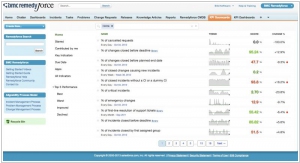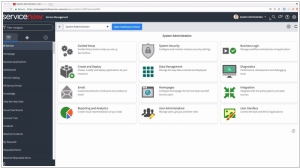Remedyforce vs ServiceNow
March 15, 2025 | Author: Michael Stromann
5★
BMC Remedyforce is built on Salesforce1 cloud platform to deliver complete IT service management functionality with the secure social, mobile, and collaborative capabilities users expect. Intuitive administration and configuration keeps you focused on delivering business value. Personalized self-service gives users new access to service offerings. Automation and integration reduce manual labor and streamline service delivery. Dashboards and analytics drive information sharing and informed decisions.
49★
ServiceNow offers a portfolio of robust cloud-based products that automate and manage IT service relationships across the enterprise. Our products have the advantage of being built on a single cloud platform that consists of one user interface, one code base and one data model, delivering easy, automated upgrades. ServiceNow provides an intuitive and approachable user experience complete with expert services to accelerate time-to-value.
Well, it turns out Remedyforce and ServiceNow are both remarkably similar in that they’re both designed to manage IT services in the cloud, where the mystical magic of incident and change management unfolds before your very eyes. They both allow you to automate workflows, which is wonderful because, as we all know, humans love the idea of having fewer things to manually click on. Essentially, they exist to help businesses run smoother, more efficiently—sort of like the hyper-efficient intergalactic bureaucracies you might encounter in a parallel universe, but less alien.
Now, Remedyforce, bless its heart, arrived in 2011, having been built on the Salesforce platform—making it the slightly more approachable cousin in the IT service management family. It's particularly fond of small to mid-sized businesses, offering them an affordable, out-of-the-box solution that might remind you of a particularly eager intern trying to help but occasionally tripping over their own shoelaces. And while it’s rooted firmly in the U.S., its main party trick is how effortlessly it integrates with Salesforce, making you wonder why you’d ever want to use anything else when you’ve got all those shiny Salesforce tools at your disposal.
Then there’s ServiceNow, which has been around since 2004 and despite its somewhat grandiose name, it’s not just for IT service management. It also handles things like HR, security and customer service, sort of like a Swiss Army knife but with the weight of an entire corporate empire behind it. ServiceNow, with its penchant for customization, tends to attract larger enterprises, the kind that have more departments than you can shake a stick at and might actually need all that flexibility. Also hailing from the U.S., it’s the platform for those who need more than just incident tickets—it's for those who require an all-encompassing service management universe, potentially with a team of developers ready to tweak things to perfection.
See also: Top 10 IT Service Desk software
Now, Remedyforce, bless its heart, arrived in 2011, having been built on the Salesforce platform—making it the slightly more approachable cousin in the IT service management family. It's particularly fond of small to mid-sized businesses, offering them an affordable, out-of-the-box solution that might remind you of a particularly eager intern trying to help but occasionally tripping over their own shoelaces. And while it’s rooted firmly in the U.S., its main party trick is how effortlessly it integrates with Salesforce, making you wonder why you’d ever want to use anything else when you’ve got all those shiny Salesforce tools at your disposal.
Then there’s ServiceNow, which has been around since 2004 and despite its somewhat grandiose name, it’s not just for IT service management. It also handles things like HR, security and customer service, sort of like a Swiss Army knife but with the weight of an entire corporate empire behind it. ServiceNow, with its penchant for customization, tends to attract larger enterprises, the kind that have more departments than you can shake a stick at and might actually need all that flexibility. Also hailing from the U.S., it’s the platform for those who need more than just incident tickets—it's for those who require an all-encompassing service management universe, potentially with a team of developers ready to tweak things to perfection.
See also: Top 10 IT Service Desk software





